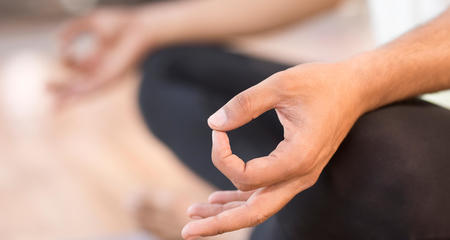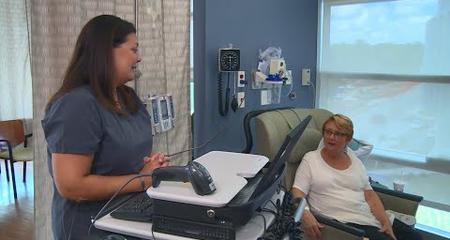Oncodermatology is a dedicated specialty of dermatology that focuses on supportive management of cancer treatment side effects that affect the skin, hair and nails. Oncodermatology also manages cancer-related skin conditions such as graft-versus-host disease (GVHD, when donor cells attack the skin — such as cells provided for bone marrow transplant), as well as skin conditions that are the result of internal cancers. GVHD and skin side effects from cancer treatment can cause blistering, sun-sensitive rashes, eczema-like symptoms and red and scaly skin.
Side effects of cancer treatment that affect the skin, hair and nails are common, generally uncomfortable and highly visible. These conditions may have a significant impact on quality of life and a patient’s psychological well-being. Many patients view these side effects as more difficult to endure than traditionally recognized side effects, such as nausea and fatigue.
The Froedtert & MCW Cancer Network offers the only program dedicated to oncodermatology in the state of Wisconsin, providing dedicated supportive management to patients with cancer-related conditions of the skin, hair and nails. We collaborate directly with your cancer team to ensure cancer treatments and supportive management of their side effects work well together for your benefit.
Oncodermatologist Versus Dermatologic Oncologist
- A dermatologic oncologist specializes in treating skin cancers like basal and squamous cell carcinomas, melanoma and cutaneous T-cell lymphoma.
- An oncodermatologist specializes in managing cancer treatment toxicities (side effects) to the skin, hair and nails that can arise from any cancer treatment for any type of cancer.
Cancer treatment side effects can lead to a decrease in your treatment dosing, prevent you from completing treatment or result in changes to your treatment. These actions not only affect quality of life, they can also influence treatment outcomes.
Prompt evaluation and treatment by an oncodermatologist can lead to improved quality of life and may allow you to continue lifesaving or life-prolonging treatment without interruption. The goal is to decrease or eliminate the impact of treatment toxicities (side effects).
With access to treatment for highly visible conditions of the skin, hair and nails during and after cancer treatment, patients often feel “more like themselves” and regain or retain their self-esteem.
Common Dermatologic Cancer Treatment Side Effects
Virtually any cancer treatment — chemotherapy, radiation, immunotherapy, targeted therapy — can cause dermatologic issues. You may experience some of the following changes while undergoing cancer treatment.
Skin Changes
- Dry skin
- Itching
- Redness
- Rashes
- Skin thickening and texture changes
- Blisters
- Sores or inflammation of the mouth or genitals
Hair Changes
- Hair loss
- Changes in hair texture
- Excessively long or inverted eyelashes
Nail Changes
- Dry or brittle nails
- Nail plate deformities or irregularities
- Infection or inflammation of the nail folds
Conditions That Need Medical Treatment
It is very important that you tell your cancer team about any treatment-related side effects. We can help you manage milder conditions at home with guidance. More severe conditions require treatment by an oncodermatologist, including:
- Pain
- Sudden or severe itching
- Sores (especially open sores and wet sores)
- Hives and rashes
Self-Care for Oncodermatology
If you experience any uncomfortable cancer-related symptoms of the skin, hair or nails, talk with your cancer care team. Ask about a referral to an oncodermatologist so you can learn how to manage any side effects. Here are some questions to start the conversation.
- Before I start cancer treatment, what side effects could impact my skin, hair and nails?
- What proactive steps can I take to prevent or reduce these side effects?
- What specific skin/hair/nails problems could I experience — and which side effects need medical treatment urgently?
- What products do you recommend during cancer treatment — and which products should I stay away from?
Additionally, you can incorporate gentle skin, nails and hair care in your daily routine. Your cancer doctor or oncodermatologist can suggest products that are safe and gentle. Our Small Stones Wellness Centers offer skin, nail and hair products and cosmetics that are safe and work well during cancer treatment. Small Stones also offers wig fitting, head shaving, wigs and head wraps.
Treatments We Offer for Cancer Side Effects
An oncodermatologist will offer a variety of treatments for skin, hair and nail disorders caused by cancer treatment. Depending on the condition, therapies can include specific creams or ointments to apply to skin and nails, targeted medications to reduce skin inflammation, and multiple strategies to alleviate skin itching and discomfort.
-
Hair Loss and Hair Care
After chemotherapy, hair typically grows back in two or three months. After radiation therapy, it often takes from three to six months for your hair to begin growing again.
We can discuss topical or oral minoxidil to help if your hair does not grow back fully. This medication is safe to use during and after most cancer treatments. It is a non-hormonal medication, so it can usually be used in patients with hormonally active or hormonally sensitive cancers, such as breast, ovarian and prostate cancers.
You can ask your provider about a chemo cap, which cools the hair and scalp during treatment and has been effective in reducing hair loss for some people.
In the meantime, treat your hair and scalp gently.
- Wash your hair less often, and don’t scrub your scalp vigorously. Massage gently with your fingertips only.
- Don’t color your hair.
- Use gentle shampoos.
- Avoid anything that could hurt or irritate your scalp, such as hair dryers, hair irons, gels, foams, clips, hairpins, tight bands, tight braiding and hair extensions.
- Instead of rubbing your hair dry, pat it with a soft towel to remove excess water.
-
Chemo Rash

Chemo rash can present in a variety of ways on different skin tones and types. Chemo rash can start as skin that looks red and feels warm. It can present in many different ways and may look different on different skin tones.
An oncodermatologist may recommend certain skin cleansers and moisturizers or may prescribe medicines to make you more comfortable and reduce the appearance of your rash.
-
Itchy or Dry Skin
Itching and dry skin are common side effects of many cancer therapies. Though common, both can be quite bothersome. Fortunately, there are many gentle, effective ways to reduce itching and dryness.
Here are some suggestions on how to care for your skin to decrease itching and dryness.
In the shower or bath
- Use lukewarm water. Avoid water that is too hot or too cold.
- Use enough soap to remove dirt and oil but avoid using so much that you see a thick lather.
- Use soap only in the areas that become oily or stinky, such as your face, underarms, groin, buttocks and feet. Clean all other areas with warm water alone.
- Avoid vigorous scrubbing with a washcloth, sponge or brush. Just use your hands to wash.
- Use a fragrance-free mild soap. See examples of gentle products below.
- Limit time in the shower or bath to 5-10 minutes.
- Avoid using bubble bath or scented bath bombs.
After showering or bathing
- Gently pat your skin dry with a towel.
- Moisturize within a few minutes of getting out of the shower or bath to "lock-in" moisture. You may need to use moisturizers several times a day. Use a gentle, fragrance-free moisturizer. See examples of gentle moisturizers below.
- In addition, there are several excellent over-the-counter anti-itch lotions and creams. These have special ingredients that calm the skin and soothe the nerves that produce itching. See examples below.
Other suggestions
- Avoid using colognes, perfumes and scented sprays as these can irritate sensitive skin.
- Use unscented laundry products, including detergents and fabric softeners.
- Try to avoid wearing tight or rough clothing. Wool clothes and new clothes can be irritating. Consider wearing silk or cotton clothing underneath irritating fabrics.
- During the dry winter months, use a humidifier to help prevent dry skin. Remember to keep the humidifier clean to avoid mold growth.
Examples of gentle, fragrance-free soaps
- CeraVe® hydrating cleanser bar
- CeraVe hydrating body wash
- Vanicream® cleansing bar
- Vanicream body wash for sensitive skin
- Eucerin® advanced body and face cleanser
Examples of gentle, fragrance-free moisturizers
- CeraVe moisturizing cream
- CeraVe itch relief moisturizing cream
- Cetaphil® body moisturizer
- Vanicream moisturizing cream
- Eucerin advanced repair cream
- Eucerin intensive repair lotion
- Aveeno® skin relief moisture repair cream
Examples of over-the-counter anti-itch lotions and creams
- Sarna® Itch Relief Lotion
- Sarna for Sensitive Skin Itch Relief Lotion
- Eucerin Itch Relief Calming Lotion
- CeraVe Itch Relief Moisturizing Lotion
- CeraVe Itch Relief Moisturizing Cream
-
Sun Protection
It is common for skin to become more sensitive to sunlight during treatment for cancer. Fortunately, there are many ways to protect skin from sunlight and prevent sensitivity, irritation, and rashes.
Here are some suggestions on how to protect your skin from sunlight.
- Avoid intense sun exposure and always avoid indoor tanning.
- Try to avoid being in direct sunlight when possible, particularly when the sun is most intense between 10 a.m. and 2 p.m.
- Try to stay in shaded areas when outdoors when possible.
- Do not use tanning beds or booths. No amount of indoor tanning is safe! Even small amounts of indoor tanning before vacations or events can cause damage to your skin.
- Wear sun protective clothing. Examples of good sun protective clothing include:
- A hat with a wide brim
- Shirts with high collars and long sleeves that are of a darkly colored, tightly weaved fabric
- Long pants that are of a darkly colored, tightly weaved fabric
- Clothing that is specifically designed to protect your skin from the sun, which is designated as having a UPF (ultraviolet protection factor)
- Use sunscreen whenever you are in the sun. A good sunscreen has the following features:
- A minimum of SPF 30
- Broad spectrum protection against UVA and UVB rays
- Water resistance
- If possible, look for sunscreens that have the designation "PA+++" or "PA++++" on the label. This new system rates sunscreens' ability to block UVA rays.
If the sunscreen meets these criteria, you should use whichever sunscreen you like best. See a list of recommended sunscreens below. Lotion or cream sunscreens will be gentler on the skin than spray sunscreens.
How to Apply Sunscreen
- Apply to all exposed skin 20 – 30 minutes before you are out in the sun.
- Re-apply every 2 hours.
- If you are swimming or sweating, reapply every 80 minutes or immediately after towel drying the skin.
Examples of Sunscreens
Sensitive skin: Look for sunscreens that contain only zinc oxide or titanium dioxide as the active ingredients. Lotion or cream sunscreens are preferred, as spray sunscreens are often more irritating to sensitive skin.
- Vanicream® sunscreen SPF 50
- Aveeno® baby continuous protection
- Elta MD® UV pure broad spectrum
- Blue Lizard® baby suncreen
- Blue Lizard sensitive sunscreen
- LaRoche-Posay® antihelios mineral
- Supergoop® play mineral sunscreen
Sport and sweat resistance: Sweat and water resistance does not mean waterproof. This sunscreen should still be reapplied frequently.
- Elta MD UV sport broad spectrum
- Elta MD UV active
- La Roche-Posay Antihelios melt-in sunscreen
- La Roche-Posay Antihelios sport
- Supergoop Play sunscreen
Lightweight, non-greasy feel:
- Sun Bum® original lotion
- Bare Republic® clear screen
- Bare Republic mineral sunscreen gel lotion
- La Roche-Posay Antihelios sport
- Supergoop unseen sunscreen
- Neutrogena® ultra sheer dry touch sunscreen
Face: For any facial sunscreen, it is important to make sure the product is "noncomedogenic" meaning that it will not clog the pores and cause acne.
- Elta MD UV daily
- Elta MD UV clear
- Bare Republic mineral sunscreen gel lotion for face
- La Roche-Posay Antihelios clear skin oil free sunscreen
- Supergoop mattescreen
- Supergoop every single face sunscreen
- Neutrogena clear face oil free sunscreen
Tinted sunscreens for melasma and issues with skin pigmentation:
- Elta MD UV elements tinted
- Supergoop mattescreen
- Supergoop glowscreen
- La Roche-Posay Antihelios tinted mineral sunscreen for face
- Colorescience® Sunforgettable face primer tinted or brush-on sunscreen
- Coola® tinted sunscreen
- MDSolarsciences® mineral tinted cream
Lip sunscreens: It is very important to protect your lips from the sun too!
- Supergoop lip shield and fusion lip balms
- Elta MD UV lip balm
- Tizo® tinted lip protection
- Vanicream lip sunscreen
- Avoid intense sun exposure and always avoid indoor tanning.
-
Fingernail and Toenail Treatments
Nail issues can vary. Gentle, fragrance-free moisturizers (emollients) can help with dry cuticles and nail beds. Clear, thickening nail lacquers can strengthen dry or brittle nails.
Oncodermatology Expertise in Treating Cancer Side Effects
Recognized as High Performing by U.S. News & World Report
Froedtert Hospital is recognized by U.S. News & World Report as high performing in three adult specialties and 16 procedures and conditions, including cancer.
Blogs, Patient Stories, Videos And Classes






